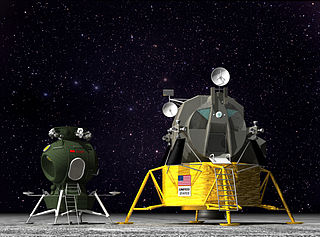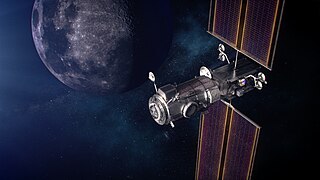Related Research Articles

A lunar module is a lunar lander designed to allow astronauts to travel between a spacecraft in lunar orbit and the lunar surface. As of 2021, the Apollo Lunar Module is the only lunar module to have ever been used in human spaceflight, completing six lunar landings from 1969 to 1972 during the United States' Apollo program.

Blue Origin Enterprises, L.P., commonly referred to as Blue Origin is an American aerospace manufacturer, government contractor, launch service provider, and space technologies company headquartered in Kent, Washington, United States. The company makes rocket engines for United Launch Alliance (ULA)'s Vulcan rocket and manufactures their own rockets, spacecraft, satellites, and heavy-lift launch vehicles. The company is the second provider of lunar lander services for NASA's Artemis program and was awarded a $3.4 billion contract. The four rocket engines the company has in production are the BE-3U, BE-3PM, BE-4 and the BE-7.

A lunar lander or Moon lander is a spacecraft designed to land on the surface of the Moon. As of 2024, the Apollo Lunar Module is the only lunar lander to have ever been used in human spaceflight, completing six lunar landings from 1969 to 1972 during the United States' Apollo Program. Several robotic landers have reached the surface, and some have returned samples to Earth.

The Crew Exploration Vehicle (CEV) was a component of the U.S. NASA Vision for Space Exploration plan. A competition was held to design a spacecraft that could carry humans to the destinations envisioned by the plan. The winning design was the Orion spacecraft.

Dynetics is an American applied science and information technology company headquartered in Huntsville, Alabama. Its primary customers are the United States Department of Defense (DoD), the United States Intelligence Community, and National Aeronautics and Space Administration (NASA).

Artemis 3 is planned to be the first crewed Moon landing mission of the Artemis program and the first crewed flight of the Starship HLS lander. Artemis 3 is planned to be the second crewed Artemis mission and the first American crewed lunar landing since Apollo 17 in December 1972. In December 2023, the Government Accountability Office reported that the mission is not likely to occur before 2027; as of January 2024, NASA officially expects Artemis 3 to launch no earlier than September 2026 due to issues with the valves in Orion's life support system.

The Lunar Gateway, or simply Gateway, is a space station which is planned to be assembled in orbit around the Moon. The Gateway is intended to serve as a communication hub, science laboratory, and habitation module for astronauts as part of the Artemis program. It is a multinational collaborative project: participants include NASA, the European Space Agency (ESA), the Japan Aerospace Exploration Agency (JAXA), the Canadian Space Agency (CSA) and the Mohammed Bin Rashid Space Centre (MBRSC). The Gateway is planned to be the first space station beyond low Earth orbit.

Blue Moon is a family of lunar landers and their associated infrastructure, intended to carry humans and cargo to the Moon, under development by a consortium led by Blue Origin and including Lockheed Martin, Draper, Boeing, Astrobotic, and Honeybee Robotics. Two versions of Blue Moon are under development: a robotic lander planned to land on the Moon in 2024, and a larger human lander planned to land a crew of four astronauts on the lunar surface for the NASA Artemis V mission in 2029.

The Artemis program is a Moon exploration program led by the United States' National Aeronautics and Space Administration (NASA), formally established in 2017 via Space Policy Directive 1. It is intended to reestablish a human presence on the Moon for the first time since the Apollo 17 mission in 1972. The program's stated long-term goal is to establish a permanent base on the Moon to facilitate human missions to Mars.

Artemis 4 is a planned mission of the NASA-led Artemis program. The mission will include the fourth use of a Space Launch System (SLS) launch vehicle, will send an Orion spacecraft with four astronauts to the Lunar Gateway space station, install a new module on the Gateway, and conduct the second lunar landing of the Artemis program.

Artemis 5 is the fifth planned mission of NASA's Artemis program and the first crewed flight of the Blue Moon lander. The mission will launch four astronauts on a Space Launch System rocket and an Orion to the Lunar Gateway and will be the third lunar landing of the Artemis program. In addition, Artemis V will also deliver two new elements to the Gateway Space Station.

The Boeing Human Landing System (HLS) was the name of a proposed lunar lander concept by Boeing that was submitted by Boeing to NASA on 5 November 2019 as part of the Artemis program and the NextSTEP H. The proposal was presented as the "quickest and simplest method" for a 2024 Moon landing. The lunar lander concept was not selected for funding by NASA as part of Artemis in the 30 April 2020 announcement.

Starship HLS is a lunar lander variant of the Starship spacecraft that is slated to transfer astronauts from a lunar orbit to the surface of the Moon and back. It is being designed and built by SpaceX under the Human Landing System contract to NASA as a critical element of NASA's Artemis program to land a crew on the Moon.
The Dynetics Autonomous Logistics Platform for All-Moon Cargo Access (ALPACA)—also known as Dynetics HLS—(ILV) is a human spaceflight lunar lander design concept proposed in 2020/21 for the NASA Human Landing System (HLS) component of the Artemis program. Dynetics was the lead contractor for the ALPACA lander—other contractors included Sierra Nevada Corporation—for NASA's Artemis Program.
A Human Landing System (HLS) is a spacecraft in the U.S. National Aeronautics and Space Administration's (NASA) Artemis program that is expected to land humans on the Moon. These are being designed to convey astronauts from the Lunar Gateway space station in lunar orbit to the lunar surface, sustain them there, and then return them to the Gateway station. As of 2024 NASA intends to use Starship HLS for Artemis III, an enhanced Starship HLS for Artemis IV, and a Blue Origin HLS for Artemis V.
Starlab is a planned LEO commercial space station, which is expected to launch no earlier than 2028. It is currently being designed by Starlab Space, a joint venture between Voyager Space and Airbus. It is planned to be launched before the decommissioning of the ISS.

On 13 August 2021, Blue Origin filed a complaint to the United States Court of Federal Claims about NASA's award of $2.9 billion to SpaceX. The award was used by the company to further develop Starship HLS, a lunar lander that NASA selected for the Artemis program. On 4 November 2021, the Court of Federal Claims dismissed the complaint, and the accompanying memorandum opinion was titled Blue Origin v. United States & Space Exploration Technologies Corp. Blue Origin's complaint and prior actions have received attention from the news media and spaceflight industries.

The Lunar Terrain Vehicle (LTV) is an unpressurized rover being developed for NASA that astronauts can drive on the Moon while wearing their spacesuits. The development of the LTV is a part of NASA's Artemis Program, which involves returning astronauts to the Moon, specifically the lunar south pole, by 2026, but the LTV will not fly until Artemis V in 2030 at the earliest. The LTV will be the first crewed lunar rover developed by NASA since the Lunar Roving Vehicle used during the Apollo program.
The Commercial LEO Destinations program is a public/private partnership program of the NASA, to help facilitate the building of private commercial space stations (CSSs) in low Earth orbit.
References
- 1 2 3 4 Burghardt, Thomas (1 May 2020). "NASA Selects Blue Origin, Dynetics, and SpaceX Human Landers for Artemis". NASASpaceFlight.com . Archived from the original on 15 May 2020. Retrieved 12 June 2020.
- 1 2 3 4 Potter, Sean (30 April 2020). "NASA Names Companies to Develop Human Landers for Artemis Missions". NASA. Archived from the original on 11 May 2020. Retrieved 12 June 2020.
- 1 2 3 Burghardt, Thomas (20 April 2021). "After NASA taps SpaceX's Starship for first Artemis landings, agency looks to on-ramp future vehicles". SpaceNews . Archived from the original on 20 April 2021. Retrieved 21 April 2021.
- 1 2 Berger, Eric (16 April 2021). "NASA selects SpaceX as its sole provider for a lunar lander - "We looked at what's the best value to the government."". Ars Technica . Archived from the original on 17 April 2021. Retrieved 21 April 2021.
- 1 2 Foust, Jeff (16 April 2021). "NASA selects SpaceX to develop crewed lunar lander". SpaceNews . Archived from the original on 21 May 2021. Retrieved 21 April 2021.
- 1 2 3 4 5 "Jeff Bezos' Blue Origin sues NASA, escalating its fight for a Moon lander contract". The Verge. 16 August 2021. Archived from the original on 16 August 2021. Retrieved 16 August 2021.
protest prevented SpaceX from starting its contract for 95 days while the GAO adjudicated the case.
- 1 2 Foust, Jeff (30 July 2021). "GAO denies Blue Origin and Dynetics protests of NASA lunar lander contract". SpaceNews . Archived from the original on 18 September 2021. Retrieved 2 August 2021.
- 1 2 Sheetz, Michael (16 August 2021). "Bezos' Blue Origin takes NASA to federal court over award of lunar lander contract to SpaceX". CNBC . Archived from the original on 16 August 2021. Retrieved 16 August 2021.
- 1 2 3 4 Couluris, John (11 June 2020). Human Landing System: Putting Boots Back on the Moon. American Astronomical Society. Event occurs at 5:45–9:20. Retrieved 12 June 2020– via YouTube.
- 1 2 NextSTEP H: Human Landing System Archived 2020-12-08 at the Wayback Machine , NASA, 27 January 2021, retrieved 31 January 2021.
- ↑ Potter, Sean (30 April 2020). "NASA Names Companies to Develop Human Landers for Artemis Missions". NASA. Archived from the original on 11 May 2020. Retrieved 15 May 2020.
 This article incorporates text from this source, which is in the public domain .
This article incorporates text from this source, which is in the public domain . - ↑ Berger, Eric (30 April 2020). "NASA awards lunar lander contracts to Blue Origin, Dynetics—and Starship". Ars Technica . Archived from the original on 13 May 2020. Retrieved 12 June 2020.
- ↑ Lueders, Kathryn (16 April 2021). "Appendix H: Human Landing System, Option A Next Space Technologies for Exploration Partnerships-2 (NextSTEP-2) (page 8)" (PDF). NASA HLS Option A Source Selection Statement . Archived (PDF) from the original on 8 May 2021. Retrieved 5 June 2021.
- ↑ "Statement on Blue Origin-Dynetics Decision". 30 July 2021. Archived from the original on 18 September 2021. Retrieved 17 August 2021.
- ↑ "Despite Competitor Protests NASA Pays SpaceX $300 Million To Continue Developing A Starship Lunar Lander". 14 August 2021. Archived from the original on 16 August 2021. Retrieved 17 August 2021.
- 1 2 "Blue Origin wins lion's share of NASA funding for human-rated lunar lander". Archived from the original on 2020-05-01. Retrieved 2020-06-15.